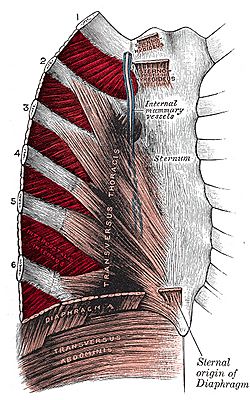Intercostal muscles facts for kids
Quick facts for kids Intercostal muscles |
|
|---|---|
 |
|
| Intercostal muscles highlighted in dark red. | |
| Latin | Musculi intercostales |
| Artery | intercostal arteries |
| Nerve | intercostal nerves |
The intercostal muscles are a group of muscles found between your ribs. They are super important because they help form and move your chest wall. These muscles play a big part in how you breathe, helping your chest cavity get bigger and smaller.
Contents
What Are Intercostal Muscles?
Your intercostal muscles are like a team of helpers for your lungs. They work together to make sure you can take breaths in and out. There are three main types of these muscles, each with a special job.
External Intercostal Muscles
The External intercostal muscles are on the outside. They help you take a breath in, whether you are breathing normally or taking a deep breath. These muscles start on ribs 1 through 11 and attach to ribs 2 through 12.
When you breathe in, these muscles lift your ribs. This makes your thoracic cavity (the space inside your chest) wider. Their fibers point downwards and forwards.
Internal Intercostal Muscles
The Internal intercostal muscles are found underneath the external ones. They help you push air out when you breathe out forcefully. For example, when you blow out candles or sigh. Normally, breathing out is a relaxed process, but these muscles step in when you need more power.
These muscles start on ribs 2 through 12 and attach to ribs 1 through 11. They pull your ribs down and inward. This makes your chest cavity smaller, pushing air out. Their fibers point downwards, forwards, and sideways, making a right angle with the external muscles.
Innermost Intercostal Muscles
The Innermost intercostal muscles are the deepest layer. They are very similar to the internal intercostal muscles. A special group of nerves and blood vessels runs between the internal and innermost layers. Like the internal muscles, their fibers also point downwards, forwards, and sideways.
How Do Intercostal Muscles Work?
Both the external and internal intercostal muscles get their signals from intercostal nerves. These nerves are part of your thoracic spinal nerves. The muscles also get blood from intercostal arteries and have blood drained away by intercostal veins. It's interesting that their muscle fibers run in opposite directions, which helps them do their different jobs of lifting and lowering the ribs.
Other Muscles for Breathing
Besides the main intercostal muscles, other muscles also help you breathe. The scalene muscles are an example. They also help move the chest wall and assist with breathing in.
See also
 In Spanish: Músculos intercostales para niños
In Spanish: Músculos intercostales para niños
- Thoracic diaphragm, another important muscle for breathing.
- Exhalation
- Inhalation

